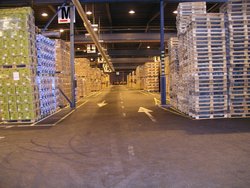Warehouse
|
|
Hochregallager.jpg
A warehouse is a commercial building for storage of goods. Warehouses are used by manufacturers, importers, exporters, wholesalers, transport businesses, customs, etc. They are usually large plain buildings in industrial parts of towns. They come equipped with loading docks to load and unload trucks; or sometimes are loaded directly from railways, airports, or seaports. They also often have cranes and forklifts for moving goods, which are usually placed on ISO standard pallets.
Some warehouses are completely automated, with no workers working inside. The pallets and product are moved with a system of automated conveyors and automated storage and retrieval machines coordinated by programmable logic controllers and computers running logistics automation software. These systems are often installed in refrigerated warehouses where temperatures are kept very cold to keep the product from spoiling, and also where land is expensive, as automated storage systems can use vertical space efficiently up to 10 metres and higher.
Traditional warehousing has been declining since the last decades of the 20th century with the gradual introduction of just in time (JIT) techniques designed to improve the return on investment of a business by reducing in-process inventory. The JIT system promotes the delivery of objects straight from the factory to the retail merchant, or from parts manufacturers directly to a large scale factory such as an automobile assembly plant, without the use of warehouses. However, with the gradual implementation of offshore outsourcing and offshoring in about the same time period, the distance between the manufacturer and the retailer (or the parts manufacturer and the industrial plant) grew considerably in many domains, necessitating at least one warehouse per country or per region in any typical supply chain for a given range of products.
Recent developments in marketing have also led to the development of warehouse-style retail stores with extremely high ceilings where decorative shelving is replaced by tall heavy duty industrial racks, with the items ready for sale being placed in the bottom parts of the racks and the crated or pallet-borne and wrapped inventory items being usually placed in the top parts. In this way the same building is used both as a retail store and a warehouse.
Vacant warehouses were an often used location in the late 1980s and early to mid 1990s for illegal raves.

